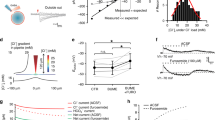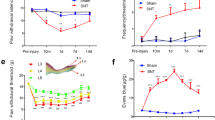Abstract
Sensory relay structures in the spinal cord dorsal horn are now thought to be active processing structures that function before supraspinal sensory integration. Dorsal horn neurons directly receive nociceptive (pain) signals from the periphery, express a high degree of functional plasticity and are involved in long-term sensitization and chronic pain. We show here that deep dorsal horn neurons (DHNs) in Wistar rats can switch their intrinsic firing properties from tonic to plateau or endogenous bursting patterns, depending upon the balance of control by metabotropic glutamate (mGlu) and GABAB receptors. We further show that this modulation acts on at least one common target, the inwardly rectifying potassium channel (Kir3). Finally, we found that these firing modes correspond to specific functional states of information transfer in which dorsal horn neurons can faithfully transmit, greatly enhance or block the transfer of nociceptive information.
This is a preview of subscription content, access via your institution
Access options
Subscribe to this journal
Receive 12 print issues and online access
$209.00 per year
only $17.42 per issue
Buy this article
- Purchase on Springer Link
- Instant access to full article PDF
Prices may be subject to local taxes which are calculated during checkout





Similar content being viewed by others
References
Willis, W.D. & Coggeshall, R.E. Sensory Mechanisms of the Spinal Cord 2nd edn. (Plenum Press, New York, 1991).
Urban, L., Thompson, S.W.N. & Dray, A. Modulation of spinal excitability: cooperation between neurokinin and excitatory amino acid neurotransmitters. Trends Neurosci. 17, 432–438 (1994).
Cook, A.J., Woolf, C.J., Wall, P.D. & McMahon, S.B. Dynamic receptive field plasticity in rat spinal cord dorsal horn following C-primary afferent input. Nature 325, 151–153 (1987).
Millan, M.J. The induction of pain: an integrative review. Prog. Neurobiol. 57, 1–164 (1999).
Woolf, C.J. & Salter, M.W. Neuronal plasticity: increasing the gain in pain. Science 288, 1765–1769 (2000).
Russo, R.E. & Hounsgaard, J. Plateau-generating neurones in the dorsal horn in an in vitro preparation of the turtle spinal cord. J. Physiol. (Lond.) 493, 39–54 (1996).
Morisset, V. & Nagy, F. Nociceptive integration in the rat spinal cord: role of nonlinear membrane properties of deep dorsal horn neurons. Eur. J. Neurosci. 10, 3642–3652 (1998).
Morisset, V. & Nagy, F. Plateau potential-dependent windup of the response to primary afferent stimuli in rat dorsal horn neurons. Eur. J. Neurosci. 12, 3087–3095 (2000).
Russo, R.E., Nagy, F. & Hounsgaard, J. Inhibitory control of plateau properties in dorsal horn neurons in the turtle spinal cord in vitro. J. Physiol. (Lond.) 506, 795–808 (1998).
Le Masson, G., Le Masson, S., Debay, D. & Bal, T. Feedback inhibition controls spike transfer in hybrid thalamic circuits. Nature 417, 854–858 (2002).
Dascal, N. Signaling via the G protein-activated K+ channels. Cell. Signal. 9, 551–573 (1997).
Sodickson, D.L. & Bean, B.P. GABAB receptor–activated inwardly rectifying potassium current in dissociated hippocampal CA3 neurons. J. Neurosci. 16, 6374–6385 (1996).
Takamori, S., Rhee, J.S., Rosenmund, C. & Jahn, R. Identification of a vesicular glutamate transporter that defines a glutamatergic phenotype in neurons. Nature 407, 189–194 (2000).
Herzog, E. et al. The existence of a second vesicular glutamate transporter specifies subpopulations of glutamatergic neurons. J. Neurosci. 21, RC181 (2001).
Tennigkeit, F., Schwarz, D.W. & Puil, E. Effects of metabotropic glutamate receptor activation in auditory thalamus. J. Neurophysiol. 82, 718–729 (1999).
Levine, M.W. Cross-correlation between neurons: a source of information about the nervous system. Biosystems 48, 139–146 (1998).
Usrey, W.M. The role of spike timing for thalamocortical processing. Curr. Opin. Neurobiol. 12, 411–417 (2002).
Di Prisco, G.V., Pearlstein, E., Robitaille, R. & Dubuc, R. Role of sensory-evoked NMDA plateau potentials in the initiation of locomotion. Science 278, 1122–1125 (1997).
Beurrier, C., Congar, P., Bioulac, B. & Hammond, C. Subthalamic nucleus neurons switch from single-spike activity to burst- firing mode. J. Neurosci. 19, 599–609 (1999).
Kawasaki, H., Palmieri, C. & Avoli, M. Muscarinic receptor activation induces depolarizing plateau potentials in bursting neurons of the rat subiculum. J. Neurophysiol. 82, 2590–2601 (1999).
Lo, F.S. & Erzurumlu, R.S. L-type calcium channel-mediated plateau potentials in barrelette cells during structural plasticity. J. Neurophysiol. 88, 794–801 (2002).
Russo, R.E. & Hounsgaard, J. Dynamics of intrinsic electrophysiological properties in spinal cord neurons. Prog. Biophys. Mol. Biol. 72, 329–365 (1999).
Jiang, M.C., Liu, L. & Gebhart, G.F. Cellular properties of lateral spinal nucleus neurons in the rat L6-S1 spinal cord. J. Neurophysiol. 81, 3078–3086 (1999).
Jiang, M.C., Cleland, C.L. & Gebhart, G.F. Intrinsic properties of deep dorsal horn neurons in the L6-S1 spinal cord of the intact rat. J. Neurophysiol. 74, 1819–1827 (1995).
Kangrga, I., Jiang, M.C. & Randic, M. Actions of (−) baclofen on rat dorsal horn neurons. Brain Res. 562, 265–275 (1991).
Sharon, D., Vorobiov, D. & Dascal, N. Positive and negative coupling of the metabotropic glutamate receptors to a G protein–activated K+ channel, GIRK, in Xenopus oocytes. J. Gen. Physiol. 109, 477–490 (1997).
Morisset, V. & Nagy, F. Ionic basis for plateau potentials in deep dorsal horn neurons of the rat spinal cord. J. Neurosci. 19, 7309–7316 (1999).
Sharp, A.A., O'Neil, M.B., Abbott, L.F. & Marder, E. Dynamic clamp: computer-generated conductances in real neurons. J. Neurophysiol. 69, 992–995 (1993).
Le Masson, G., Le Masson, S. & Moulins, M. From conductances to neural network properties: analysis of simple circuits using the hybrid network method. Prog. Biophys. Mol. Biol. 64, 201–220 (1995).
McCormick, D.A. & Bal, T. Sleep and arousal: thalamocortical mechanisms. Annu. Rev. Neurosci. 20, 185–215 (1997).
De Koninck, Y. & Henry, J.L. Substance P–mediated slow excitatory postsynaptic potential elicited in dorsal horn neurons in vivo by noxious stimulation. Proc. Natl. Acad. Sci. USA 88, 11344–11348 (1991).
Sotgiu, M.L., Biella, G. & Riva, L. Post-stimulus afterdischarges of spinal WDR and NS units in rats with chronic nerve constriction. Neuroreport 6, 1021–1024 (1995).
Woolf, C.J. & King, A.E. Subthreshold components of the cutaneous mechanoreceptive fields of dorsal horn neurons in the rat lumbar spinal cord. J. Neurophysiol. 62, 907–916 (1989).
Russo, R.E. & Hounsgaard, J. Short-term plasticity in turtle dorsal horn neurons mediated by L-type Ca2+ channels. Neuroscience 61, 191–197 (1994).
Baranauskas, G. & Nistri, A. Sensitization of pain pathways in the spinal cord: cellular mechanisms. Prog. Neurobiol. 54, 349–365 (1998).
Herrero, J.F., Laird, J.M. & Lopez-Garcia, J.A. Wind-up of spinal cord neurons and pain sensation: much ado about something? Prog. Neurobiol. 61, 169–203 (2000).
Lombard, M.C. & Larabi, Y. Electrophysiological study of the cervical dorsal horn cells in partially deafferented rats. in Advances in Pain Research and Therapy (eds. Bonica, J., Lindblom, U. & Iggo, A.) 147 (Raven Press, New York, 1983).
Calvino, B., Villanueva, L. & Le Bars, D. Dorsal horn (convergent) neurons in the intact anaesthetized arthritic rat. I. Segmental excitatory influences. Pain 28, 81–98 (1987).
Asada, H., Yamaguchi, Y., Tsunoda, S. & Fukuda, Y. Relation of abnormal burst activity of spinal neurons to the recurrence of autonomy in rats. Neurosci. Lett. 213, 99–102 (1996).
Bettler, B., Kaupmann, K. & Bowery, N. GABAB receptors: drugs meet clones. Curr. Opin. Neurobiol. 8, 345–350 (1998).
Couve, A., Moss, S.J. & Pangalos, M.N. GABAB receptors: a new paradigm in G-protein signaling. Mol. Cell. Neurosci. 16, 296–312 (2000).
Neugebauer, V. Metabotropic glutamate receptors—important modulators of nociception and pain behavior. Pain 98, 1–8 (2002).
Hao, J.-X., Xu, X.-J., Yu, Y.-X., Seiger, A. & Wiesenfeld-Hallin, Z. Baclofen reverses the hypersensitivity of dorsal horn wide dynamic range neurons to mechanical stimulation after transient spinal cord ischemia; implications for a tonic GABAergic inhibitory control of myelinated fiber input. J. Neurophysiol. 68, 392–396 (1992).
Lin, Q., Peng, Y.B. & Willis, W.D. Role of GABA receptor subtypes in inhibition of primate spinothalamic tract neurons: difference between spinal and periaqueductal gray inhibition. J. Neurophysiol. 75, 109–123 (1996).
Russo, R.E., Nagy, F. & Hounsgaard, J. Modulation of plateau properties in dorsal horn neurones in a slice preparation of the turtle spinal cord. J. Physiol. (Lond.) 499, 459–474 (1997).
Delgado-Lezama, R., Perrier, J.F., Nedergaard, S., Svirskis, G. & Hounsgaard, J. Metabotropic synaptic regulation of intrinsic response properties of turtle spinal motoneurons. (J. Physiol. Lond.) 504, 97–102 (1997).
Schneider, S.P., Eckert, W.A. & Light, A.R. Opioid-activated postsynaptic, inward rectifying potassium currents in whole cell recordings in substantia gelatinosa neurons. J. Neurophysiol. 80, 2954–2962 (1998).
Adriaensen, H., Gybels, J., Handwerker, H.O. & Van Hees, J. Response properties of thin myelinated (A-delta) fibers in human skin nerves. J. Neurophysiol. 49, 111–122 (1983).
Destexhe, A., Mainen, Z.F. & Sejnowski, T.J. Synthesis of models for excitable membranes, synaptic transmission and neuromodulation using a common kinetic formalism. J. Comput. Neurosci. 1, 195–230 (1994).
Inokuchi, H., Yoshimura, M., Yamada, S., Polosa, C. & Nishi, S. Fast excitatory postsynaptic potentials and the responses to excitant amino acids of sympathetic preganglionic neurons in the slice of the cat spinal cord. Neuroscience 46, 657–667 (1992).
Acknowledgements
We are grateful to S. El Mestikawy (INSERM U513) for the gift of the anti-VGluT antibodies and to S. Shefchyk (SCRC, Univ. of Manitoba Winnipeg) for helpful discussions and careful reading of the manuscript. This work was supported by grants from the Conseil Régional d'Aquitaine (20010301213), the Direction Générale des Armées (01.34.012.00470.75.01), the Institut UPSA de la Douleur, the Fondation de la Recherche Médicale (ARI20010406005/1) and the Fondation Singer-Polignac.
Author information
Authors and Affiliations
Corresponding author
Ethics declarations
Competing interests
The authors declare no competing financial interests.
Rights and permissions
About this article
Cite this article
Derjean, D., Bertrand, S., Le Masson, G. et al. Dynamic balance of metabotropic inputs causes dorsal horn neurons to switch functional states. Nat Neurosci 6, 274–281 (2003). https://doi.org/10.1038/nn1016
Received:
Accepted:
Published:
Issue Date:
DOI: https://doi.org/10.1038/nn1016
This article is cited by
-
Noradrenergic inhibition of spinal hyperexcitation elicited by cutaneous cold stimuli in rats with oxaliplatin-induced allodynia: electrophysiological and behavioral assessments
The Journal of Physiological Sciences (2017)
-
GABA Pharmacology: The Search for Analgesics
Neurochemical Research (2014)
-
Local Signalization in Dendrites and Mechanisms of Short-Term Memory
Neurophysiology (2013)
-
Regulation of Wnt Signaling by Nociceptive Input in Animal Models
Molecular Pain (2012)
-
Peripheral Nerve Injury Increases Glutamate-Evoked Calcium Mobilization in Adult Spinal Cord Neurons
Molecular Pain (2012)



